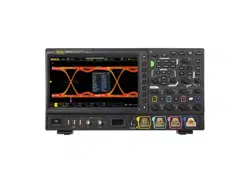Loading ...
Loading ...
Loading ...

7.4 Sample Rate
Sampling is the process of converting the analog signal into the digital signal at a
specified time interval and then restoring them in sequence. The sample rate is the
reciprocal of the time interval.
The sample rate of the analog channel is related to the current channel mode. The
maximum real-time sample rate in the single-channel mode of the oscilloscope is 10
GSa/s. The maximum real-time sample rate in the dual-channel mode is 5 GSa/s, and
the maximum real-time sample rate in the 4-channel mode is 2.5 GSa/s.
TIP
Single-channel mode: only one of the four channels (CH1/CH2/CH3/CH4) is enabled.
Dual-channel mode: either CH1 or CH2 is enabled; and either CH3 or CH4 is enabled.
4-channel mode: CH1/CH2 are both enabled or CH3/CH4 are both enabled.
NOTE
The sample rate is displayed both in the status bar at the upper part of the screen and in the
CH SampleRate menu. To indirectly modify the sample rate, rotate the Horizontal SCALE
knob to adjust the horizontal time base or modify the memory depth. In addition, if the
triggering source selects the analog channel, the channel mode will be changed, and thus
affecting the sampling rate.
The impact of low sample rate on the waveform:
1. Waveform Distortion: when the sample rate is too low, some waveform details
are lost, and the sample waveform displayed is rather different from the actual
waveform of the signal.
2. Waveform Aliasing: when the sample rate is twice lower than the actual signal
frequency (Nyquist Frequency), the frequency of the waveform rebuilt from the
sample data is smaller than the actual signal frequency.
To Set the Sample System
Copyright ©RIGOL TECHNOLOGIES CO., LTD. All rights reserved.
71
Loading ...
Loading ...
Loading ...
